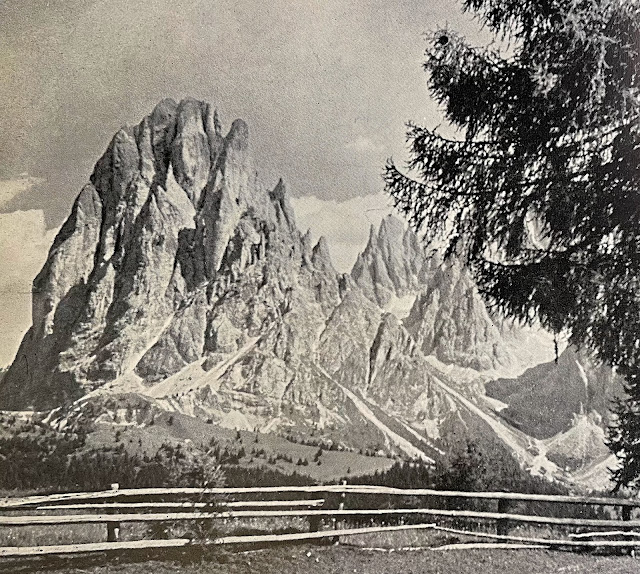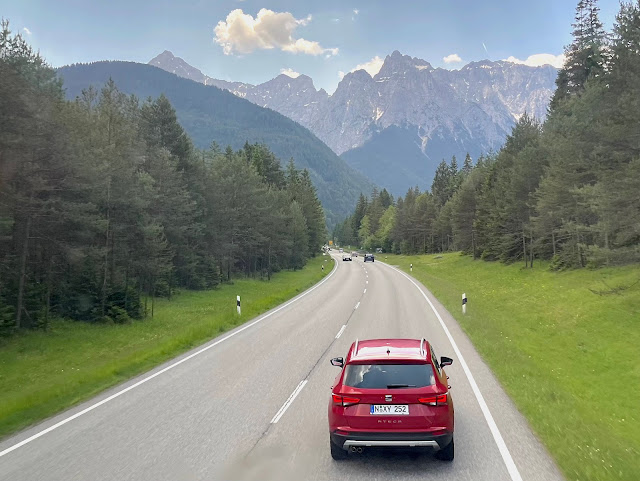Sometime in the late 1970s, while studying geology at Northern Arizona University, I came across some photos of the Dolomite Mountains in Italy. To say they were spectacular in those few photos would not convey adequately the way they touched me deeply. I vowed to go there one day. Then a few months after I met Helen Thompson in 2005, she casually asked me if there was any place I had not yet been that I would like to one day go. The "wheels" in that imaginary slot machine spun around in my head for a few moments, bypassing Milford Sound in New Zealand, Perth, Australia, and the Karoo in South Africa, until it finally settled on... the Dolomites. So I blurted out to her. "The Dolomite Mountains in Italy!" She never forgot that and 18 years later she made that dream come true for me.
This will probably take a few posts to capture the length and breadth of our trip. It was amazing in every way, scenically, physically, geologically, culturally, and culinarily. I'll try to embed the flavor of each of these somehow in this and subsequent posts.
 |
| The location of the Dolomite Mountains in northeast Italy |
But first, what about that initial photo from the late 70s? It must have been in some geology textbook, showing the clearly deformed nature of the sedimentary rocks in the Italian Alps. (BTW, I had never seen nor visited the Alps before, a huge "hole" in my geologic résumé). In 1985, I purchased a used copy of a book called, "The Dolomites," by C. Douglas Milner, published in Great Britain in 1951. He was a climber and by then numerous Brits were making their way to the Dolomiti. It seems I was still on the trail of these (to me) elusive mountains.
 |
An image from Milner's book. Scenes like this inspired me to one day visit the Dolomites. |
Our trip would include a nine-day trek over 85 miles in length through rugged mountains on what turned out to be poorly maintained trails (my personal post-hike assessment). But travel that far requires extra time to accommodate to the changes in time zones, insurance against delayed (or lost) gear, and to visit other desirable nearby places. So we flew in and out of Munich Germany with additional visits to Innsbruck Austria and Bolzano Italy.
 |
| Marienplatz in Munich's city center |
We arrived into Munich on time in the early afternoon, checked into our hotel and adjusted to the time zone by staying awake until it was bedtime in Munich. We were well situated to the city center and walked to the Marienplatz (translation: Mary's Plaza). The Old World style of building always fascinates us Americans. As does World War II history and Munich has much of that (although we did not partake of much of that - except a very interesting and highly reflective visit to Dachau, the first of the concentration camps).
 |
| The Seigestor Gate on Munich's north side, commissioned by King Ludwig I in 1852 |
We enjoyed Munich very much. There was a lot of history and Helen got to revisit the famous Hofbrauhaus from a childhood visit in 1970. We spent two night here and enjoyed it. But it was time to head south as we had not yet seen any mountains. That would soon change.
 |
| On the road southwest toward Garmisch-Partenkirchen, Germany |
We booked a Flix public transport on a double-decker bus. I did this in advance of the trip and saw that you could reserve specific seats. So I booked the very front two seats on the upper deck with a large windshield, so that we could look out and watch the landscape unfurl. About an hour out of Munich we captured our first glimpse of the Alps. One in Garmisch-Partenkirchen the officials came onboard and seriously checked out the passports of everyone on the coach - the driver was incensed that now he would be late getting in to Innsbruck.
 |
| The Inn River in Zurl, Austria |
We crossed the divide between Germany and Austria and soon the road descended steeply into the valley of the Inn River. It was spectacular. The river begins farther west in Switzerland and flows east toward the Danube. There is a very obvious terrace that was apparent everywhere in the Inn Valley and a quick internet search suggested that it may be Pleistocene in age. The terrace is visible in the photo above. 10,000 years of downcutting by the Inn River may have formed the geomorphology here.
 |
| A pedestrian bridge in Innsbruck's city center |
We loved walking the old city center in Innsbruck (The name means "Inn River bridge"). We walked everywhere, including the old tower, climbing 159 steps for a great view of the city. The public transport is easy and cheap. In fact, most hotels in the Tyrolian Alps will give guests a card to use public transport for free! I participated in a guest survey while in Innsbruck that asked how it would be paid for (they don't have it yet here). But while in Italy, our hotel hosts freely gave us these cards. They even include rides on the mountain gondola's - considered public transport. All very civilized, modern, and sensible. One other aspect I noticed on this trip - many dates given for the founding of these cities were about the mid-12th century. Munich, Innsbruck, Bolzano - they all seemed to have been established about that time. Makes me wonder if the Medieval Warm Period may have facilitated an expansion of humanity around that time? And interesting thought.
 |
| Colorful buildings along the north bank of the Inn River in Innsbruck |
The city had 60% of its building damaged in World War II and those in the photo above look like newer construction. You can read a bit more about the bombing of Innsbruck here. Sad to think about as the vibe today is completely different - gelato shops everywhere! We were still just getting our bearing on being in such a foreign land so we did not venture too far from the city center and there was plenty to see here. But the gondola looks like a nice destination for the next trip.
 |
| Arizona meets Austria |
We ran into our dear friend Bil while in Innsbruck. His wife is of German descent and she comes to Germany often to visit family. It was a quick trip for him on the train from Garmisch-Partenkirchen to Innsbruck.
 |
| View of the Dolomite Mountains from Monguelfo, Italy |
Finally, we caught a train from Innsbruck to Italy and the staging area for our trek, Monguelfo. Northeast Italy used to be part of Austria until the end of World War I, when Italy took over some parts of that territory. You can read more about this interesting history
here. Therefore, all towns in this area have two names, a German name and an Italian name. Monguelfo is Italian but it is also called Welsberg. It is a quaint and friendly town. We loved it and our hotel hosts were so kind to us.
Now the hard part would begin - a nine day trek through the mountains. But the rewards were great and well worth the sweat equity!










Love these photos and your writing! Oh, to be 20, or at least 10, years younger! I've always been intrigued by photos of the Dolomites. Can't wait to read about the trek.
ReplyDeleteSounds like a fabulous trip -- I look forward to reading future posts! The Dolomites have been on my travel wish list for a long time also; hopefully I'll get there someday.
ReplyDelete